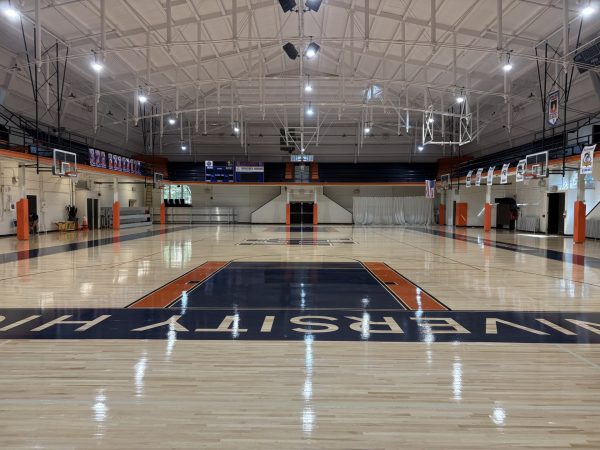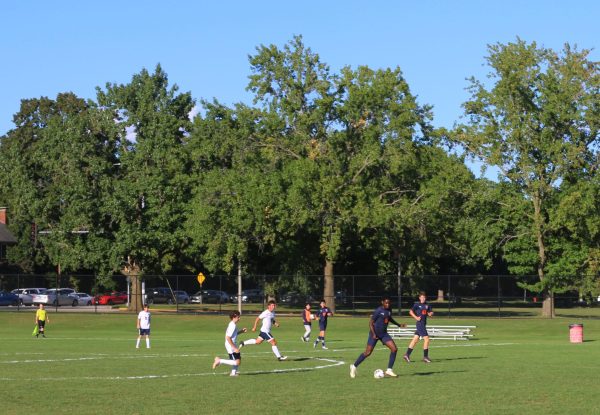Recent active threat drill reveals strengths, limitations of school shooting procedures
An active threat drill took place at Uni on February 8 at 8:15 AM, lasting about 5 minutes. Two weeks earlier, students attended mandatory assemblies in which administrators Dr. Jeanette Nuckolls and Dr. Karl Radnitzer reviewed procedures and went over changes to the drill.
Uni, like the University of Illinois, follows “the run, hide, fight emergency response paradigm that’s advocated by the Department of Homeland Security,” says Lieutenant Todd Short of the University of Illinois Police Department. He spoke to Uni students last year about safety during an active threat.
Drills such as the one that took place Friday are meant to help students practice the run-hide-fight mindset.
“Sometimes people just freeze,” Nuckolls acknowledges. “But every individual has to make a decision. Run, hide, fight…you develop these [mental] pathways.”
“We acquire skills through repetition, mental and physical repetition,” says Short. During drills, “You’ve got to pretend it’s a real deal.” However, he says that “It’s very difficult to practice [running and fighting]…If there’s a lot of unknowns, a lot of times the preferred method is the hide part.”
In the event of an active threat, both Short and Nuckolls agree that it is up to the individual to make the right choice for the situation.
Nuckolls says that students should do “anything that will distract or discourage someone from coming into the room.”
For example, during a previous drill, she went to the biology lab to tell them the drill was over. “In Mr. Stone’s lab, where he had his roaches–they put that in front of the door,” says Nuckolls. “So when I came to let them know that it was all clear…I wouldn’t go in.”
Examining other schools and their training methods may shed light on the effectiveness of Uni’s methods in the event of a real-life emergency.
Marjory Stoneman Douglas High School in Parkland, Florida, which experienced a shooting one year ago that killed 17 people, underwent similar drill preparation, according to the This American Life story “Before the Next One”. They were told, if you’re not in a classroom, run, and keep running. If you’re in a classroom, make sure the windows are covered, the doors are locked–in other words, hide.
A Stoneman Douglas teacher said, “I don’t think we could have been more prepared than we were.” They spent two days going over active threat procedures for every class period. They “wanted to make sure that the kids knew the procedures, that it was ingrained in their mind and that they knew.” Uni’s drills are intended to accomplish the same thing.
Teachers from Stoneman Douglas said after the fact that it was useful to have a “playbook” for what to do. Similarly, according to Short, Uni teachers are expected to go through 5 clear steps. In addition to covering the windows, they need to “lock it or block it”.
“[Teachers should] take themselves and their students and hide in a place they aren’t supposed to be seen. It’s called a safety corner,” says Short. “[They should] make sure everyone’s cell phones are on silent…. [They should] make sure all the people in that space remain quiet.”
Finally, they should not come out until either a known first responder comes, or they get an Illini Alert, a University of Illinois service that sends emergency alerts.
Stoneman Douglas even took precautions that Uni doesn’t. They covered all their windows with paper. They kept their classrooms locked all day, every day, based on what happened in Sandy Hook, where the shooter entered a classroom as the teacher was going to lock it. Still, the shooting had 17 casualties.
One key difference between Uni and Stoneman Douglas is that some of the teachers at Stoneman Douglas had undergone hyperrealistic surprise drills with blanks, and many teachers expected such a drill to take place. As a result, there was initial confusion as to whether the event was a drill or real.
Uni does not do hyperrealistic simulations, and the intercom message clearly states whether it is a drill or not.
“You’ve got to be real careful with that [surprise drills],” says Short. “I think they absolutely should be announced. I would never do it unannounced.”
According to “Before the Next One”, most school safety experts think surprise drills with blanks are a bad idea. One expert said that “teachers who’ve been through one of these surprise drills perform worse on [their] simulations than teachers who have no training at all. They forget crucial steps, like calling the police, and commit more dangerous mistakes.”
Nuckolls says that non-surprise simulations could be valuable. “I’ve participated in simulations like that before . . . But again it’s only one way of preparing.” She says Illinois State University recently went through a simulation that involved the entire community. While time and resources is an issue, she says, “I think any way to prepare individuals is a good way.”
Another difference between Stoneman Douglas’s and Uni’s procedures is what the drill itself is called. At Stoneman Douglas, an active threat was called a “code red”. Experts say that such language is confusing.
“If I say ‘code red,’ it takes a split second for your brain to go, OK, code red means bad, means active shooter, means I have to do this, versus if I say there is a gunman in the school,” says Cheryl Jonson, an active threat researcher and training instructor.
Uni’s new school-wide intercom system broadcasts a new message to play in the event of an active thrill. Rather than mentioning a “code red”, it is a simple recording of teacher Rick Murphy saying, “Attention in the building, an active threat has been detected. Please react appropriately.”
It’s hard to say how many of these similarities and differences are meaningful. Overall, there simply is not enough data to definitively determine the effectiveness of school shooting drills. As a result, different schools use different strategies–and Uni has its own.
When students and teachers heard the active drill alert over the intercom on Friday, they reacted calmly, using the ‘hide’ strategy.
“We just locked the door and turned off the lights,” says senior Olivia Taylor. “We just kept working.”
However, Taylor doesn’t think the drill completely gauges how prepared students are for an active threat, especially an active shooter.
“Knowing it’s a drill kind of takes away the urgency,” Taylor says. “I just feel like there’s no way to predict how I would react in that situation.”
Short agrees there are limits to how much a student can prepare for an active threat.
“There’s no right answer,” Short says. “You have to breath…relax yourself, make as clear a decision as you can possibly make.”

